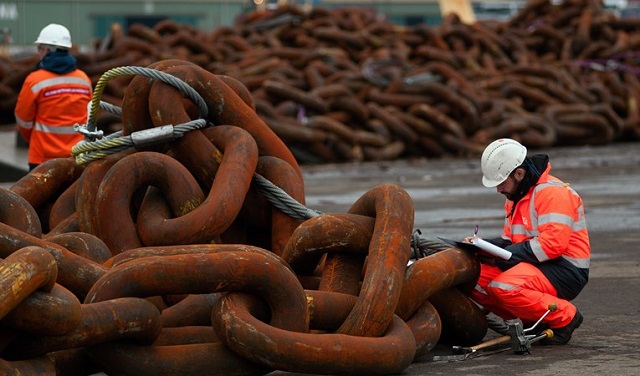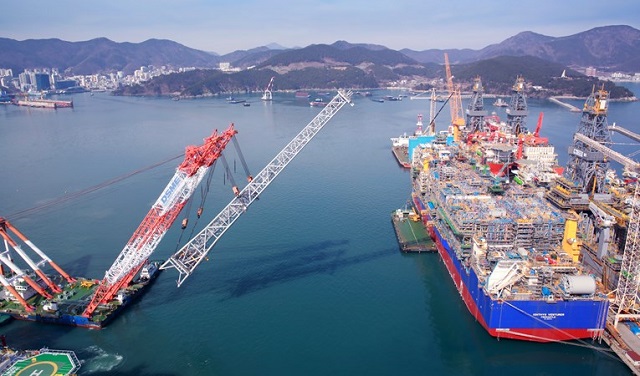Ichthys in Pictures
The Inpex-operated Ichthys LNG project has reached a significant milestone with completion of the offshore pre-lay of the 77 kilometer (48 mile) chain and cable mooring system in the Browse Basin, located off the northern coast of Western Australia.
As part of the mooring system, 49 chains were laid on the seabed in water depths of up to 250 meters (820 feet) and anchored to foundation piles—5.5 meters (18 feet) in diameter and 63 meters (207 feet) long.

The mooring system will secure the project’s two massive offshore facilities—the central processing facility (CPF) and FPSO facility—in the Ichthys field seabed for at least 40 years of continuous operation.
Once located in the field, the CPF will deliver natural gas and some condensate through an 890 kilometer (550 mile) subsea gas export pipeline to onshore processing facilities in the Northern Territory. Most condensate will be processed through the FPSO and shipped directly to market from the field.
Supplying more than 40,000 tons of large-scale anchor chains for the project represented nearly 18 months of worldwide chain production. Each chain link weighs more than 700 kilograms.
The 28 CPF mooring chains required more than 25,000 tons of mainly 178 millimeter diameter chain, while the 21 FPSO mooring chains needed more than 15,000 tons of mainly 161 millimeter diameter chain.
The mooring system is part of the complex network of subsea infrastructure and equipment across the Ichthys field.
Ichthys Project Managing Director Louis Bon said the mooring system pre-lay was a significant undertaking with challenging soil conditions for the piling scope of work.
“For example, because the Ichthys field is located just 120 kilometers (75 miles) from the main hump back whale migratory routes and calving grounds of North West Australia, an early decision was made to avoid pile driving during the whale calving period where associated underwater noise may have created a disturbance.”
Bon said the successful completion of the mooring chains pre-lay marked another major step ahead of the arrival of the CPF and FPSO currently under construction in ship yards in South Korea and, once completed, will be towed 5,600 kilometers (3,500 miles) to the Ichthys field.
"The offshore facilities will operate for decades and the mooring system plays a key role in ensuring their integrity.”
In addition to the mooring system, more than 16,000 tons of subsea structures and 140 kilometers (87 miles) of rigid flowlines have been installed across the Ichthys field to extract gas and condensate.
The Ichthys field has reserves estimates from two geological horizons of around twelve trillion cubic feet of gas and five hundred million barrels of condensate. This makes it the largest discovery of hydrocarbon liquids in Australia in more than 40 years.
When operational, the project is expected to produce 8.4 million tons of LNG and 1.6 million tons of LPG per annum, along with approximately 100,000 barrels of condensate per day at peak.
.jpg)
The Ichthys LNG project’s massive central processing facility float off, South Korea, September 2015.

The Ichthys project’s floating, production, storage and offloading facility flare tower installation, South Korea, February 2016.
.jpg)
Ichthys LNG project onshore facilities construction continues, Bladin Point near Darwin, March 2016.
.jpg)
The 6500 ton, 110 m tall riser support structure tower is prepared for its journey to the Ichthys field.
.jpg)
The top of the RSS tower above the surface for the final time before being installed on the seabed for the life of the Ichthys LNG project.
.jpg)
The RSS tower was safely launched at the Ichthys field on Wednesday November 5, 2014.
.jpg)
Deepwater pipelay vessel Castorone lay 713 kilometres of the Ichthys LNG project’s 890 kilometer gas export pipeline.
.jpg)
More than 200 huge pre-fabricated modules are needed to build the onshore liquefaction plant – some weighing as much as 3600 family cars.
.jpg)
December 2014: The Ichthys LNG project’s riser support structure arch moments before installation at the Ichthys field.
